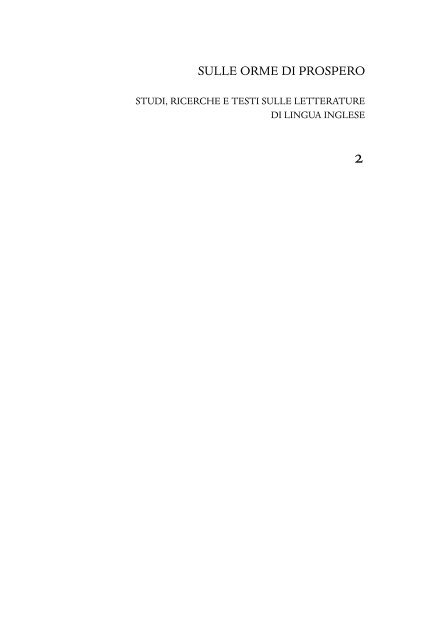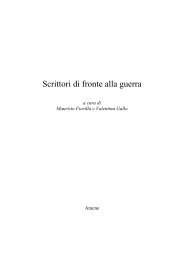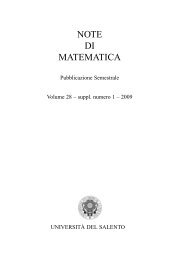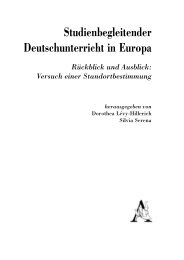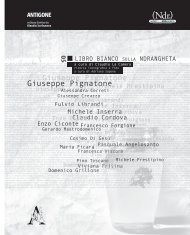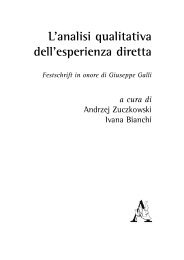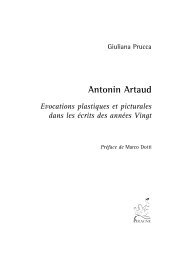SULLE ORME DI PROSPERO - Aracne editrice
SULLE ORME DI PROSPERO - Aracne editrice
SULLE ORME DI PROSPERO - Aracne editrice
Create successful ePaper yourself
Turn your PDF publications into a flip-book with our unique Google optimized e-Paper software.
<strong>SULLE</strong> <strong>ORME</strong> <strong>DI</strong> <strong>PROSPERO</strong><br />
STU<strong>DI</strong>, RICERCHE E TESTI <strong>SULLE</strong> LETTERATURE<br />
<strong>DI</strong> LINGUA INGLESE<br />
2
Direttore<br />
Alessandro GEBBIA<br />
“Sapienza” Università di Roma<br />
Comitato scientifico<br />
Paolo FABBRI<br />
Libera Università Internazionale degli Studi Sociali “Guido Carli” (LUISS)<br />
Silvia BURINI<br />
Università “Ca’ Foscari”<br />
Jean–Marie KLINKENBERG<br />
Université de Liège<br />
Isabella PEZZINI<br />
“Sapienza” Università di Roma
<strong>SULLE</strong> <strong>ORME</strong> <strong>DI</strong> <strong>PROSPERO</strong><br />
STU<strong>DI</strong>, RICERCHE E TESTI <strong>SULLE</strong> LETTERATURE<br />
<strong>DI</strong> LINGUA INGLESE<br />
Le letterature di lingua inglese rappresentano, in termini<br />
coloniali e postcoloniali, uno degli aspetti più interessanti<br />
e innovativi del mondo anglofono moderno. Australia,<br />
Canada, Caraibi, India, Nuova Zelanda e le diverse realtà<br />
dell’Africa, nate dal disgregarsi dell’Impero britannico, rappresentano<br />
oggi distinti corpi letterari in cui la memoria<br />
dell’impresa coloniale si mescola e si evolve in percorsi<br />
autonomi e originali sempre più ricchi e innovativi che,<br />
pur mantenendo il comune denominatore della lingua inglese,<br />
si costituiscono come altrettanti canoni nazionali<br />
in cui il fatto letterario sembra protendersi verso il limite<br />
estremo delle proprie possibilità. La Collana, pertanto,<br />
intende ospitare non solo studi e ricerche di carattere letterario,<br />
storico e sociologico, ma anche traduzioni di testi<br />
narrativi, poetici e teatrali attraverso i quali scoprire direttamente<br />
i protagonisti di queste letterature.
Contemporary Sites of Chaos<br />
in the Literatures and Arts<br />
of the Postcolonial World<br />
Edited by<br />
Marie–Hélène Laforest<br />
Frances Jane Wilkinson
Copyright © MMXIII<br />
ARACNE <strong>editrice</strong> S.r.l.<br />
www.aracne<strong>editrice</strong>.it<br />
info@aracne<strong>editrice</strong>.it<br />
via Raffaele Garofalo, 133/A–B<br />
00173 Roma<br />
(06) 93781065<br />
ISBN 978-88-548-6233-3<br />
I diritti di traduzione, di memorizzazione elettronica,<br />
di riproduzione e di adattamento anche parziale,<br />
con qualsiasi mezzo, sono riservati per tutti i Paesi.<br />
Non sono assolutamente consentite le fotocopie<br />
senza il permesso scritto dell’Editore.<br />
I edizione: luglio 2013
Contents<br />
7 Chaos and the Postcolonial: preliminary notes<br />
ANNALISA OBOE<br />
15 Chaos in a Box: the language of diasporic intertextualities in<br />
Suhayl Saadi<br />
ESTERINO ADAMI<br />
31 “Exiles Must Make Their Own Maps”: postcolonial texts and<br />
the explosion of cartography<br />
SIMONA BERTACCO<br />
53 Chaotic Dystopias: life after catastrophe in Margaret Atwood’s<br />
Oryx and Crake and The Year of the Flood<br />
GIUSEPPINA BOTTA<br />
69 Voicing Chaos: disorder, turmoil and bewilderment in the<br />
work of Edwige Danticat<br />
ELENA MARIA CARRARO<br />
85 A Way into Chaos: creolization and complex cultural systems<br />
ROBERTA CIMAROSTI<br />
105 Sur-viving: life and death in the Nigerian prison<br />
GIULIA D’AGOSTINI<br />
125 “People Connected to the Sky in Their Mind”: chaos and mental<br />
illness in Janet Frame and Patricia Grace<br />
PAOLA DELLA VALLE<br />
5
6<br />
141 “Actions from the South”: Teatro delle Albe and Takku Ligey<br />
Théâtre<br />
CLAU<strong>DI</strong>A GUALTIERI<br />
155 From Chaos to Canon: some reflections on South African posttransitional<br />
novels<br />
MARIA PAOLA GUARDUCCI<br />
175 Carl Gibeily’s Blueprint for a Prophet (1997): from original<br />
chaos to apocalyptic chaos<br />
JACQUELINE JONDOT<br />
185 Chaos as Social and Cultural Conflict in Aravind Adiga’s Between<br />
the Assassinations and Tabish Khair’s The Bus Stopped<br />
FEDERICA ZULLO<br />
199 Contributors
Chaos and the Postcolonial: preliminary notes<br />
Annalisa Oboe<br />
La terre est un Chaos. Le Chaos n’a ni haut ni bas, et le Chaos est beau.<br />
Édouard Glissant, Tout-monde<br />
The frame of mind from which this book stems and which fuels the<br />
following reflections on chaos is related to what is currently happening<br />
here in the “old world” – in Southern Europe, in Italy, in the Mediterranean<br />
– where we seem to experience, more than at any other time<br />
in recent history, a new season of anomy. There is a feel of the apocalyptic<br />
in the air, a sense that the old order has given way to chaos and<br />
we are facing catastrophe. It is undeniable that, in recent years, a deeprooted<br />
belief in constant development and endless progress has gradually<br />
disintegrated under the impact of unexpected changes in our lives:<br />
we have witnessed our societies wrecked by economic difficulties; the<br />
institutions and infrastructures that sustained common living are<br />
breaking down, and what we used to take for granted is disappearing,<br />
so that uncertainty and lack of hope in the future are now undermining<br />
our hold on the present and hindering our ability to see and plan<br />
ahead.<br />
As we experience this collapse, in other parts of the world – in still<br />
struggling postcolonies, in the borderscapes of migrant life, in the<br />
non-places of globalized economies, in war zones, in what many refer<br />
to as the ‘global South’ – chaos seems to be constitutive of existence<br />
itself. While people of the global North are only now closely facing<br />
the anxiety and impermanence brought about by unprecedented crises<br />
on their own home ground, people in the global South have had “crisis”<br />
literally inscribed in their everyday life for a very long time.<br />
The overall global picture is not only frightening but quite puzzling:<br />
as disasters and catastrophes, individual and public, follow one<br />
another, in the global South and the global North, we are confronted<br />
7
8<br />
Annalisa Oboe<br />
with unforeseeable and irreversible turns, and yet the world seems to<br />
go on its way as usual. Yesterday’s problems are superseded by today’s<br />
emergencies, so that crises, far from being solved, are simply<br />
reconfigured or replaced by some other set of more urgent critical circumstances.<br />
What we are confronted with is indeed “chaos”.<br />
Our wanting to look at contemporary sites of chaos, as the title of<br />
this volume states, is motivated by the will to face these chaotic times,<br />
to try and understand what chaos may mean, and also to ask why looking<br />
at chaos may be interesting for postcolonial studies scholars, writers<br />
and readers.<br />
*<br />
Much has been said about the connection between chaos theory in<br />
science and in recent literature and philosophical thinking, particularly<br />
about the way in which they talk to each other in postmodern culture.<br />
Since the 1990s, in dialogue with the new science, the humanities<br />
have actually worked around a chaotic model of both cultural and individual<br />
identity-formation, which appears particularly suited to our<br />
late modern times.<br />
Chaos theory has been called “the century’s third great revolution<br />
in the physical sciences” (Gleick 1998: 6), as it puts forward a kind of<br />
revolutionary approach to the physical world that admits irregularity,<br />
disorder, unpredictability and uncertainty. As such, it somehow limits<br />
the claims of scientific discourse, and it can be seen as “a radical acceptance<br />
of vulnerability,” to borrow a telling description of deconstruction<br />
by Gayatri Spivak (1990: 18).<br />
First of all, chaos goes against the possibility of always explaining<br />
the world in elegant, linear, reassuring equations. The most popular<br />
image in chaos theory, that of a butterfly flapping its wings on one<br />
side of the world and provoking a storm on the other side, suggests<br />
that approximation (in the name of order and beauty) can be very dangerous<br />
and ultimately lead to undesirable results; it also tells us that<br />
minimal initial variations can produce widely divergent patterns and<br />
outcomes. The implications of the Butterfly effect studied by American<br />
meteorologist Edward Lorenz in the early 1960s run deep whenever<br />
one tries to explain systems or predict change, and not only in<br />
science – chaos and chaotic interference must be accounted for from<br />
the start even when we talk, as we are doing here, about cultures.
Chaos and the Postcolonial 9<br />
The worldview that comes out of chaos theory is far from reassuring<br />
– it produces fragility and insecurity and no long-term revelations<br />
but, on the other hand, it accounts for complexity, which I think is interesting<br />
from a postcolonial cultural viewpoint, because taking chaos<br />
into account produces a complex realm with no easily identifiable hierarchies,<br />
a world where even the smallest detail is important for its<br />
power to influence and change all connections around it, even though<br />
this makes comprehensive description and prediction difficult if not<br />
impossible.<br />
In other words, what chaos theory teaches us is that it is ultimately<br />
the relation between all the elements in a given system which governs<br />
the identity of these elements, none of which can be safely discounted.<br />
To say it with Édouard Glissant, all is connected in this chaos-monde,<br />
and though we cannot project onto it a larger image of order, we can<br />
still revel in its complex dynamics and detect patterns within randomness,<br />
map what is there, and accept unpredictability as an agent of<br />
change.<br />
Chaos as complexity and relation<br />
My first point about chaos and the postcolonial has to do with disorder<br />
and connection, intricacy and entanglement.<br />
It is certainly not by chance that Glissant engages with chaos theory<br />
and explicitly articulates a poetics of chaos in his work. I wish to<br />
recall that at the beginning of his Tout-monde Glissant takes his character-narrator<br />
Mathieu Béluse through a half-hallucinatory, halfvisionary<br />
tour of the Mediterranean – from Genoa and Le Cinque<br />
Terre, to the Tremiti Islands and to Panarea passing through Naples<br />
(where, incidentally, he is kindly invited to the home of an old driver<br />
who had tried to rob him of his money in the first place) – and through<br />
these wanderings, linking sea-places to other sea-places, and islands to<br />
other islands, identical and yet dissimilar, he reflects on connection<br />
and chaos, and what appears to him a beautifully disordered universe:<br />
“The earth is chaos” Mathieu says, “and chaos is beautiful” (Glissant<br />
1993: 54).
10<br />
Annalisa Oboe<br />
Glissant then elaborates on chaotic places and erratic wanderings in<br />
“Le Chaos-monde: pour une esthétique de la Relation” (Glissant 1996:<br />
81-107), where the focus is on the relation, the repulsion, attraction,<br />
connivance and conflict among the cultures of the contemporary<br />
world. The landscape of reference is confusing and unpredictable, but<br />
chaos is not chaotic, Glissant says, and just as chaos theory seeks to<br />
keep chaos and order together (as is indicated by such famous titles on<br />
chaos theory as Prigogine 1984; and Hayles 1991), so for him chaos<br />
can indeed be beautiful, if only we make an effort of the imagination<br />
to track, or trace, not laws but constants that may make sense of complexity.<br />
I will just stress that this is what postcolonial writing and studies<br />
have been doing for quite a while, not always so self-consciously perhaps,<br />
but certainly with a programmatic eye on contact and relation, as<br />
against the isolating/exclusive linearity of grand schemes or narratives.<br />
At the core of this complexity, as often highlighted in creative<br />
and critical works, is “time”, or how we conceive the temporal factor,<br />
and this leads me to the second point I want to make about chaos and<br />
the postcolonial.<br />
Chaos as multiple temporalities and the unpredictable<br />
Glissant himself notices that in the erratic experience of contemporary<br />
cultures people live at the same time in a multiplicity of different<br />
times. What we see is that there is an anarchic temporal synchronicity<br />
of differences in the present which not only does not allow for the<br />
identification of a reassuring movement towards the future, but actually<br />
prevents us from seeing ahead.<br />
The question of the coexistence and intersection of multiple temporalities<br />
in the same cultural space and on a global scale has been recently<br />
taken up, among others, by the Cameroonian intellectual<br />
Achille Mbembe in his work on Africa (On the Postcolony, 2001), and<br />
by anthropologists Jean and John Comaroff in their book Theory from<br />
the South. Or How Euro-America is Evolving towards Africa (2011),<br />
which gives an ironic twist to the evolutionary perspective often employed<br />
in the social sciences.
Chaos and the Postcolonial 11<br />
When we ask “where is our chaotic world going?” we pose a question<br />
about (a lack of) directionality, and about how cultures exist, collide,<br />
converge or change in relation to one another. I believe that if we<br />
take “chaos” as the relational term discussed in the previous section,<br />
then one possible response to the question of directionality is that contemporary<br />
cultures are going simultaneously in multiple directions,<br />
following an intricate web of pathways that do not necessarily lead<br />
forward or backward. If indeed the directionality is multiple, as<br />
Mbembe observes in relation to Africa, which he sees as a challenging<br />
testing ground for contemporary critical theory, then we need “to draw<br />
on multiple models of time so as to avoid one-way causal models,”<br />
and stop reading our chaotic world as an implicitly negative absence<br />
of progressive linearity. What we have to account for in our study of<br />
“the contemporary” and, as regards our present endeavor, its expressions<br />
in literature and the arts is “the multiplicity of the pathways and<br />
trajectories of change” (Mbembe 2012), which challenge traditional<br />
epistemologies and bear immense creative potential. My suggestion is<br />
that what our chaotic, porous, multi-directional field of postcolonial<br />
critical and creative writing brings to the world of knowledge is partly<br />
this kind of imaginative open work, a radical openness that accounts<br />
for complexity and takes multidirectionality, difference and the unpredictable<br />
positively in its stride.<br />
In postcolonial literature there has long been a militant going<br />
against narratives of progress, which not only miss out or erase crucial<br />
points such as the cultural wealth of temporal differences, but risk<br />
perpetuating what Chimamanda Adichie has recently called, in a much<br />
quoted lecture, the “danger of a single story” (Adichie 2009) – a single,<br />
univocal story of catastrophe for some, and of success for others,<br />
which loses sight of alternative temporal and epistemological domains.<br />
What this brief discussion of chaos is adventurously putting together<br />
is jumbling time-scales, different epistemologies, a multiplication<br />
of stories of cultures, and a variety of entangled presents, to<br />
which we should probably add a multiplicity of “chutnified” pasts, to<br />
say it with Salman Rushdie. This is part of the resourcefulness of<br />
postcolonial studies, which have often been criticized, sometimes even<br />
ridiculed as “carnivalesque” but, as Robert Young says in response to
12<br />
Annalisa Oboe<br />
Jean-Francois Bayart’s critique of postcolonial studies in a recent issue<br />
of Public Culture, “I’m willing to go along with the chaos of carnival,<br />
if that means, in Bakhtinian terms, to turn the world upside<br />
down and open up new accounts of knowledge and change” (Young<br />
2011).<br />
Chaos as a form of artistic lateness for our late-style times<br />
I would like to conclude with a reflection that, from ideas revolving<br />
around questions of knowledge and the creative potential of chaos,<br />
leads me to my last point: what is chaos in/for contemporary literatures<br />
and arts? Can we say that chaos is a recognizable form of “late<br />
style” for our late modern times?<br />
I owe the reference to “late style” to one of Edward Said’s inspiring<br />
posthumous essays, “Thoughts on Late Style” (2004), later included in<br />
On Late Style: Music and Literature Against the Grain. In this work,<br />
Said talks about late style as the cipher of a kind of art that is facing<br />
death, an art that has lost its grip on totality and is courting catastrophe.<br />
Lateness, Said says quoting Adorno, is “surviving beyond survival”<br />
(2006: 11), and often in the arts this does not lead to harmony<br />
and resolution, but to difficulty, anxiety and contradiction, and to a<br />
nervous tampering with the possibility of closure.<br />
For Said, this type of lateness is a sort of deliberately unproductive<br />
productiveness, a going against, that offers fragments, blank spaces,<br />
fissures, and episodic discontinuities. It produces forms of connection<br />
but no reconciliation, forms straining in opposite directions, which are<br />
held in tension by the artist’s subjectivity, all the time struggling with<br />
fallibility, with lack of direction and ultimately, I would add, with<br />
chaos.<br />
I am aware I am arbitrarily extending what Adorno and Said<br />
thought about the late style of German composer Ludwig van Beethoven<br />
or the Sicilian writer Tomasi di Lampedusa to a discourse on art<br />
confronted with contemporary sites of chaos in the postcolonial world,<br />
or perhaps I may be gesturing towards our late art forms as contemporary<br />
sites of chaos. But this suggestion of “lateness”, in the terms in<br />
which Said describes it, seems to me to reverberate with and in the ex-
Chaos and the Postcolonial 13<br />
perience of many writers and artists today, including those discussed<br />
in the essays published in this volume.<br />
Contemporary Sites of Chaos explores how art registers, reacts to,<br />
analyzes, understands, interprets, represents today’s unruly world,<br />
which has never had to face so closely the possibility of its ending. It<br />
offers suggestive analyses of a variety of chaotic experiences which<br />
have become the object of aesthetic intervention, not only in literature<br />
but also in the performative and visual arts of the postcolonial world,<br />
celebrating the painful and dissonant beauty of imagining and creating<br />
in the face of death.<br />
References<br />
Adichie, C. (2009) “The Danger of a Single Story”. Online. Available<br />
at: (accessed 20 May 2013).<br />
Comaroff, J. and J. (2011) Theory from the South. Or How Euro-<br />
America is Evolving Towards Africa, Colorado, Boulder: Paradigm<br />
Publishers.<br />
Gleick, J. (1998 [1987]) Chaos. Making a New Science, London: Vintage<br />
Books.<br />
Glissant, E. (1993) Tout-monde, Paris: Gallimard.<br />
Glissant, E. (1996) Introduction à une poetique du divers, Paris: Gallimard.<br />
Hayles, K. ed. (1991) Chaos and Order: Complex Dynamics in Literature<br />
and Science, Chicago: The University of Chicago Press.<br />
Mbembe, A. (2001) On the Postcolony, Berkeley: University of California<br />
Press.<br />
Mbembe, A. (2012) “Africa in Theory” Online. Available at:<br />
http://africa.harvard.edu/harvard-africa-workshop/video-archive/ (accessed<br />
20 May 2013).
14<br />
Annalisa Oboe<br />
Prigogine, I. (1984) Order Out of Chaos. Man’s Dialogue with Nature,<br />
New York: Bantam Books.<br />
Said, E. (2004) “Thoughts on Late Style”, London Review of Books<br />
26.15, 5 August: 3-7.<br />
Said, E. (2006) On Late Style: Music and Literature Against the<br />
Grain, New York: Pantheon Books.<br />
Spivak, G. (1998) The Post-colonial Critic: Interviews, Strategies,<br />
Dialogue, New York and London: Routledge.<br />
Young, R. (2011) “Bayart’s Broken Kettle,” Public Culture 23.1: 167-<br />
175.
Chaos in a Box: the language of diasporic intertextualities<br />
in Suhayl Saadi<br />
Esterino Adami<br />
Writing is the act of being outside. It is the<br />
scream of the excluded.<br />
Suhayl Saadi, The Burning Mirror<br />
Essi ritenevano che il segreto fosse grande, e<br />
quanto più lui giurava di non possederlo, tanto<br />
più erano convinti che lo possedesse, e fosse un<br />
segreto vero, perché se fosse stato falso lo a-<br />
vrebbe rivelato.<br />
Umberto Eco, Il pendolo di Foucault<br />
In 2009 Suhayl Saadi, the writer of Pakistani and Afghani origin, authored<br />
Joseph’s Box, a novel in which chaos seems to be the governing<br />
paradigm, as it blends different historical, cultural and narrative<br />
levels, has a multilayered textual organisation and numerous references<br />
to European and Asian cultures. Saadi himself affirms in an interview<br />
that “[it] is not written to conform to the internal or macroscopic<br />
structures of the standard novel” (in Shaikh 2010: 151).<br />
Essentially the book involves three main overlapping storylines<br />
concerned with the lives of Zuleikha Chasm Framareza MacBeth, a<br />
general practitioner from an ethnically mixed family, Archibald Enoch<br />
MacPherson, her WWII veteran terminally ill patient, and Alexander<br />
Wolfe, a lute player. In the waters of the Clyde, Zulie and Alex find a<br />
mysterious box which contains six other boxes, each tied to an obscure<br />
clue, which actually corresponds to one leg of an east-bound<br />
journey. As the quest-based movement leads from Glasgow to Argyll,<br />
Lincolnshire, Sicily, Lahore, and Baltistan, the accumulation of<br />
Zulie’s and Alex’s dreams, hopes, fears and anxieties, along with<br />
15
16<br />
Esterino Adami<br />
Archie’s distant echoes and memories, grows into a web of stories, in<br />
which the representation of chaos is employed to tackle issues such as<br />
diaspora, identity and transformation. In this paper I will apply chaos<br />
theory to Saadi’s novel in order to show how the author audaciously<br />
expands the porous boundaries of diasporic writing.<br />
The novel is deeply rooted into a plurality of styles and modes of<br />
storytelling, drawing from music, poetry, history, myths and other cultural<br />
fields, and this technique, like a challenging game of Chinese<br />
boxes, multiplies the flow of narrations. Against this multifaceted context,<br />
I argue that chaos does not represent a mere instance of Babellike<br />
anarchy, but rather, that it encapsulates the manifestations, frictions<br />
and contradictions of cultures and traditions, as reshaped by the<br />
centripetal forces of diasporic imagination and postmodern intertextuality.<br />
The plot of the novel seems to be set in motion by a fortuitous episode,<br />
namely Zulie’s discovery of a mysterious box in the river. This<br />
apparently mundane event generates a chain of intersected stories and<br />
can be interpreted – in scientific terms – as an instance of deterministic<br />
chaos, which refers to “the context, the medium we inhabit in everyday<br />
life, ubiquitously allowing for, and indeed mandating individuality<br />
as well as unpredictability within a determined order” (Hawkins<br />
1995: 1-2). This notion of chaos seeks to cluster the number of possibilities<br />
of what can happen in real (and fictional) worlds, and determines<br />
a concatenation and combination of events, which in turn may<br />
generate consequences and repercussions. It opens up the binary opposition<br />
of order and disorder in the attempt to consider the complexities<br />
and negotiations of cultures and societies.<br />
According to Hayles, “at the centre of chaos theory is the discovery<br />
that hidden within the unpredictability of chaotic systems are deep<br />
structures of order” (1991: 1). Chaos theory therefore, rather than envisaging<br />
destiny as a prescribing monolithic and inscrutable power,<br />
tries to question the concatenations of events and consequences<br />
emerging from the ‘comingling’ of different situations. In this perspective,<br />
the multiple narrative progression that Saadi deftly works<br />
out, redesigns and goes beyond the notions of order and disorder, creating<br />
fresh alternatives, viewpoints and interpretations. Considering<br />
that “art’s complex nonlinear systems are […] inherently chaotic and
Chaos in a Box 17<br />
therefore at odds with comparatively linear critical, aesthetic, moralistic<br />
and ideological ideals of order” (Hawkins 1995: 5), the writer exploits<br />
the power of chaos in toto so as to give voice and visibility to<br />
migrants, women and the elderly, who may be regarded as liminal social<br />
subjects.<br />
To achieve such an ambitious goal, Saadi illustrates chaos through<br />
the amplified mechanisms of postmodern intertextuality, which not<br />
only reproduce the unstable condition of the contemporary age, but<br />
also capture the uncertainty of the “migrant condition”. In Saadi, intertextuality<br />
can be seen as a key strategy that permits the interspersing<br />
of different social, historical and cultural levels, combining the remaking<br />
of nationhood in the light of Scottishness and migrancy, the colonial<br />
history of Britain, the ancient customs of Arabo-Persian and<br />
Asian civilisations, as well as other references. Indeed, intertextuality<br />
can be seen as a “term which continually refers to the impossibility of<br />
singularity, unity, and thus unquestionably authority” (Allen 2000:<br />
209), and the writer adopts this tool so as to affirm the power of multiplicity<br />
within and through various cultures, languages and traditions.<br />
With regard to the extensive literary production of the author, and<br />
to Joseph’s Box in particular, Stotesbury affirms that “his narrative<br />
blends and ‘translates’ (or hybridises) mythologies and cultures, both<br />
ancient and utterly contemporary” (2010a: 90), and, as such, it shapes<br />
the mimetic processes that extensively draw on the productive sites of<br />
postcolonial and postmodern chaos. Language, thus, constructs both in<br />
the text and in the reader’s perception the overwhelming accumulation<br />
of references and symbols through which cultures influence each<br />
other.<br />
Given the textual richness of Joseph’s Box, it is important to take<br />
into account the novel’s spatial deixis, in particular the places evoked<br />
and reconstructed through the eyes of Zulie and Alex as novel wayfarers<br />
who cross geographical, cultural and mental borders to solve the<br />
enigma of the boxes. Their quest represents an act of unearthing the<br />
past and its copious cultural and historical stratifications, with their<br />
echoes of both the dimension of myth and the postcolonial heritage.<br />
The first locations that the two protagonists visit in the UK (Glasgow,<br />
Argyll and Lincoln) appear to be imaginary “stations” along a perilous<br />
pilgrimage and are portrayed as subterranean worlds belonging to a
18<br />
Esterino Adami<br />
decayed past and emerging from the accretion of detritus, memories<br />
and relics.<br />
Consequently, Zuleikha and Alex’s descent into the labyrinths of<br />
the underworld acquires mythical value as a rite of passage towards<br />
other places, other states of consciousness and perception. The two<br />
characters want to decrypt the various clues of the boxes they find, but<br />
in doing so not only do they challenge a mystery, but they also question<br />
themselves, as well as their past and present experiences. In the<br />
framework of chaos theory, the notion of myth can be seen as a fundamental<br />
interpretative category, and is reminiscent of the fact that<br />
“while myth may be paradigmatic, and while it may imply a given social<br />
and cosmic order, or perfection, it also carries with it a promise of<br />
another mode of existence entirely, a possible way of being just beyond<br />
the present time and place” (Coupe 2009: 9). By stepping into an<br />
indefinite “elsewhere”, the protagonists unconsciously decide to reshape<br />
their identities and search for a new direction in their lives.<br />
Chaos emerges as a “creative necessity” (Hawkins 1995: 4), an urge to<br />
go through knowledge and understanding, which also functions<br />
through the Pantagruelian style of the author who builds up a huge<br />
wealth of interfusing symbols, traditions and stories.<br />
After leaving Britain, the two protagonists head for Palermo and<br />
subsequently Lahore. The two cities are portrayed as “postcolonial<br />
places”, in which the chaotic signs of the past – palaces, churches,<br />
mosques, havelis – mingle together and constitute a reluctant transition<br />
towards uncertain (post) modernity (Adami 2012a). In both locations,<br />
for Alex and Zuleikha dilapidated buildings are mute and seductive<br />
witnesses of complex and ancient cultures through time and<br />
space. For the woman, Palermo is a Mediterranean city that builds up<br />
its identity by compressing histories and stories. Here, although the<br />
old buildings of the city centre are rundown and crumbling, they jealously<br />
keep secrets and meanings, transforming names, words, and traditions:<br />
The word medina meant simply the centre of a town. Palermo’s centre<br />
was a medina, since it had once been an Arab city, Bal’harm. In fact,<br />
Zuleikha had read that in those days, Palermo had been known as simply Almadina:<br />
the City. La Kalsa, Al-Aziz, Piazzetta Garraffo, Seralcadio, Lat-


